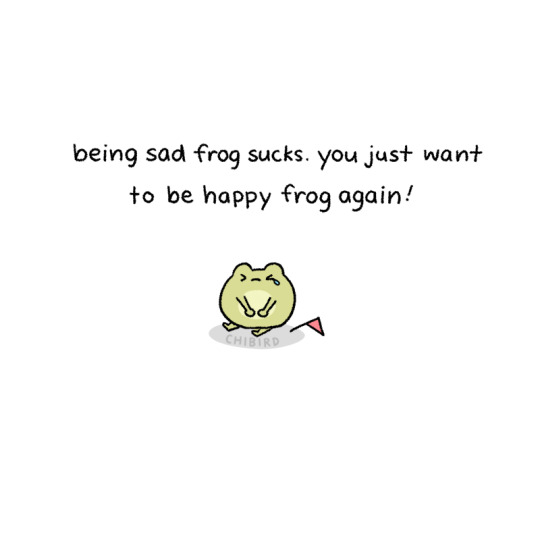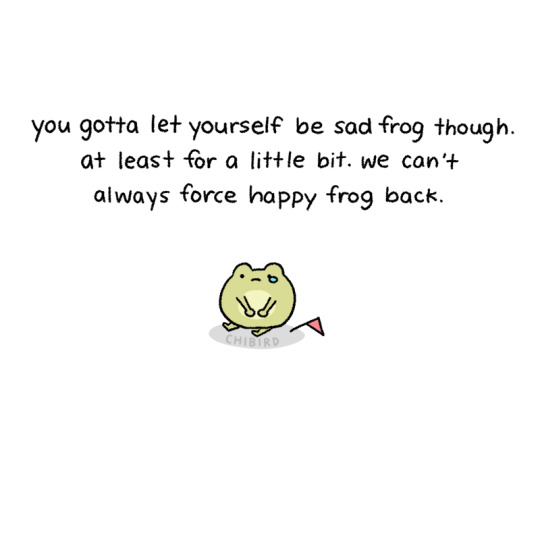Photo






Sometimes when I’m sad, I feel like a whole different self, so I made happy frog and sad frog to represent those states of mind. When I’m sad frog, I not only feel sad about the original problem, but I also feel sad about being sad frog (something I didn’t even realize was happening until I went to therapy!). This comic is a reminder that it really is okay to be sad frog. Sometimes happy frog is on a break, so be kind to your sad frog, okay? ♡
Chibird store | Positive pin club | Webtoon
12K notes
·
View notes
Text
“Do you ever miss someone but you never let them know because you have a feeling they are doing just fine without you?”
— Unknown
256 notes
·
View notes
Photo




フルーツたっぷり、シャルロット・オ・フリュイをつくりました。
つやつやしたフルーツケーキは、あたたかくなってきたこの時期に食べたいですね♪
189 notes
·
View notes
Text




🍡🍑Give me sweets and I'll love you forever 🍑🍡
🌸💀お菓子は私の弱点です💀🌸
1K notes
·
View notes
Photo



Source: The Girl From the Other Side: Siúil, a Rún / Totsukuni no Shoujo とつくにの少女
By Nagabe
2K notes
·
View notes
Text
Do you ever feel lonely but don’t want to talk to anybody?
29K notes
·
View notes
Note
hi i really want to learn kanji/katakana but i dont know where to start
Hi! Yeah, Japanese can be really daunting at first because it feels like there’s so much to learn and many places to start. I’m not sure whether or not you know hiragana already, but I’m going to list the way I started with Japanese kana (hiragana + katana) and then moved on to kanji. ლ(╹◡╹ლ)
Anything in bold is something I use/used/highly recommend!
1. LEARNING THE KANA ALPHABETS (HIRAGANA + KATAKANA)
I personally recommend learning the alphabets separately. Master one alphabet (I recommend hiragana first because it’s what you’ll use the most), and then move on to the next. I spent 2 days learning and mastering hiragana, and then slowly mastered katakana over a period of a few weeks because hiragana is everywhere, but katakana wasn’t an immediate concern for me. Obviously you need to learn both, but if you know hiragana you can jump into grammar, kanji, and other lessons while slowly mastering your katakana skills and becoming familiar with that alphabet through katakana vocabulary.
Here are some kana resources to try out!
Learn Hiragana: Tofugu’s Ultimate Guide *
Learn Katana: Tofugu’s Ultimate Guide *
Hiragana Drag-n-Drop
Katakana Drag-n-Drop
StickyStudy (phone app; on-the-go flashcards for learning kana)
Real Kana (quizzes you in different fonts to help you get used to different styles)
Practice katakana with Pokémon
* I’m not personally a fan of mnemonics, but I know a lot of people swear by them so it’s worth trying them and seeing if they work for you!
Both kana alphabets will become easier with exposure, so just keep practicing them over and over!
2. KANJI
Okay, so I’m going to be honest – everyone learns kanji differently. Some people benefit from just writing them 100 times, other people need flashcards, and some people can see them 2 or 3 times and remember them forever. You’re going to have to find the best way to learn for you, but the following resources will at least get you started. The rest is up to you ^^
Japanesetest4you – a good way to learn kanji is in vocabulary words, so once you’ve learned hiragana you can jump right in to learning new vocabulary and mastering kanji along the way! I love this websites way of splitting vocab into JLPT levels
StickyStudy (phone app) – this costs ~$9.99, but is unbelievably useful because it has kanji split into grade levels, allows you to decide how many you see everyday, and so on. I also like that I can use it on the go!
MindSnacks (phone app) – also lets you practice kana, but can expose you to kanji in a fun, game-like format
WaniKani – people have mixed feelings about this website because it works for some and not for others, but the first 3 levels are free so you can get your feet wet and decide if it’s right for you!
Memrise courses
This N5 verb list – a good start to basic, common kanji you should learn!
TEXTBOOKS + BOOKS
Genki – as far as I know, this is one of the most popular textbooks for learning Japanese and I can vouch they’re really good. They teach certain amounts of kanji each lesson and expose you to those kanji continuously, eventually removing the furigana to force your brain to remember the kanji reading + meaning alone!
Basic Kanji Book – I’ve personally never used this, but I see it everywhere on langblr and it seems like a popular way to start learning kanji
When it comes to kanji, I think it’s important to understand how to read them and understand how they work in Japanese. Almost every kanij has multiple readings. Kunyomi (訓読み) is the Japanese reading and is generally used when one kanji is by itself, while the onyomi (音読み) is the Chinese reading and appears in compounds.
For example: the kanji 話, when by itself, is read はなし (story), or はな (as in the verb ‘to speak’ - 話す, hanasu). However, when found in a compound such as telephone (電話 でんわ), the kanji is read as わ/wa. I recommend reading Tae Kim’s Guide on kanji to further understand them! Understanding how kanji operate in Japanese was really helpful for my own learning.
I think it’s also important to remember that even Japanese people didn’t learn kanji all at once! They learned them by grade, learning anywhere for 80-140 kanji per year until they were in high school. These are called The Jouyou Kanji (常用漢字) and are essentially the 2,000+ kanji Japanese people are expected to know by the government. You can learn more about them here and here.
Good luck with your studies and I hope this helps!
1K notes
·
View notes









